Report: Amazon Inc. Marketing Practices and Stakeholder Effectiveness
VerifiedAdded on 2021/04/19
|7
|1444
|72
Report
AI Summary
This report provides an analysis of Amazon Inc.'s marketing practices and organizational effectiveness from a stakeholder perspective. It begins with an introduction to the company and its purpose, which is to create an online one-stop shop for customers. The scope of operations is discussed, highlighting Amazon's global presence and diverse product offerings. The report then examines how customers, employees, and suppliers judge the company's effectiveness. Customers evaluate Amazon based on delivery speed, product availability, and quality. Employees consider salary, working environment, and growth opportunities, while suppliers assess business volume and communication. The report concludes by discussing the implications of a coherent approach to organizational effectiveness, emphasizing the need to satisfy all stakeholders to increase business, improve goodwill, and build long-term relationships. The provided references support the findings with relevant research on marketing and stakeholder management.

Marketing practices and theory
Paraphrase This Document
Need a fresh take? Get an instant paraphrase of this document with our AI Paraphraser
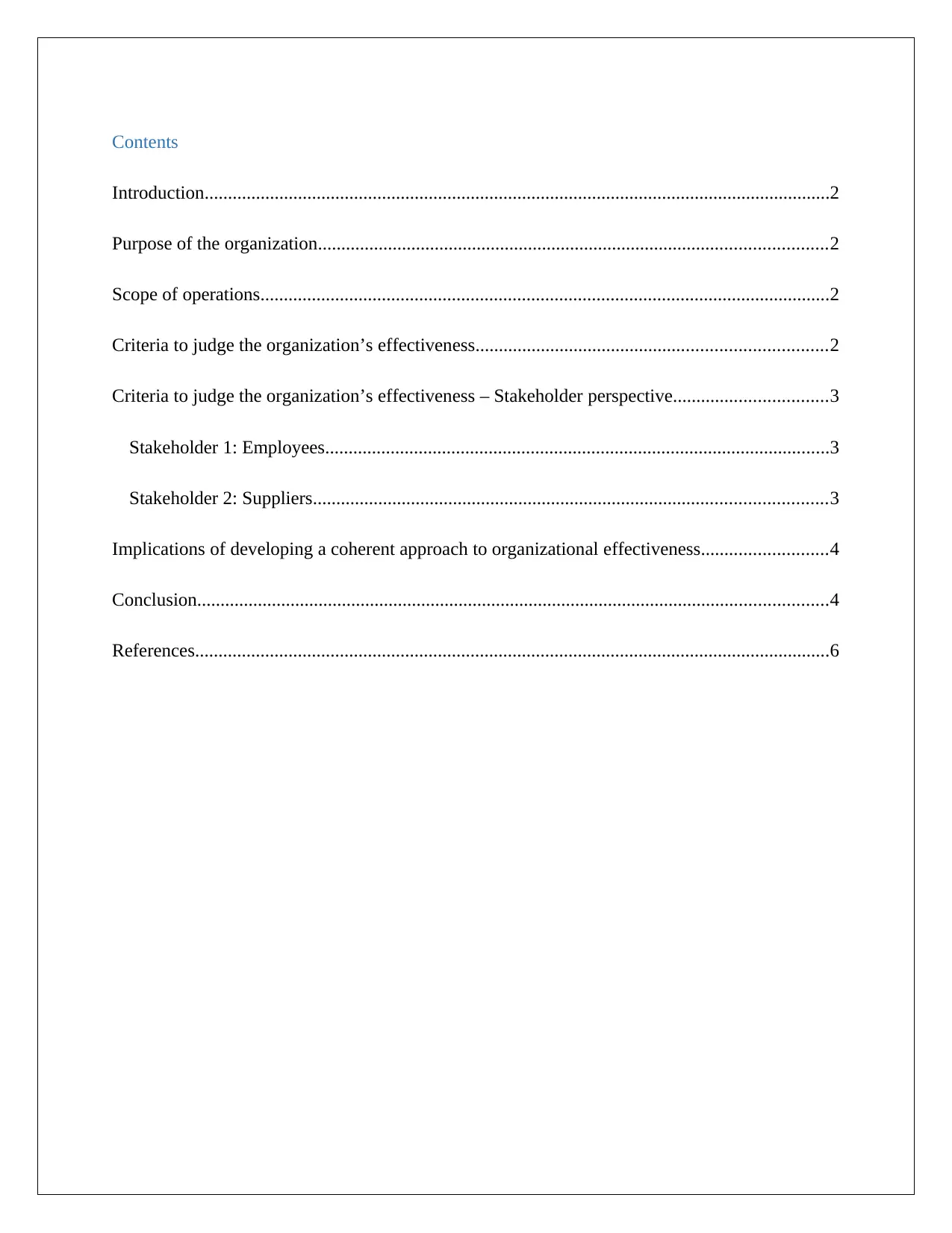
Contents
Introduction......................................................................................................................................2
Purpose of the organization.............................................................................................................2
Scope of operations..........................................................................................................................2
Criteria to judge the organization’s effectiveness...........................................................................2
Criteria to judge the organization’s effectiveness – Stakeholder perspective.................................3
Stakeholder 1: Employees............................................................................................................3
Stakeholder 2: Suppliers..............................................................................................................3
Implications of developing a coherent approach to organizational effectiveness...........................4
Conclusion.......................................................................................................................................4
References........................................................................................................................................6
Introduction......................................................................................................................................2
Purpose of the organization.............................................................................................................2
Scope of operations..........................................................................................................................2
Criteria to judge the organization’s effectiveness...........................................................................2
Criteria to judge the organization’s effectiveness – Stakeholder perspective.................................3
Stakeholder 1: Employees............................................................................................................3
Stakeholder 2: Suppliers..............................................................................................................3
Implications of developing a coherent approach to organizational effectiveness...........................4
Conclusion.......................................................................................................................................4
References........................................................................................................................................6
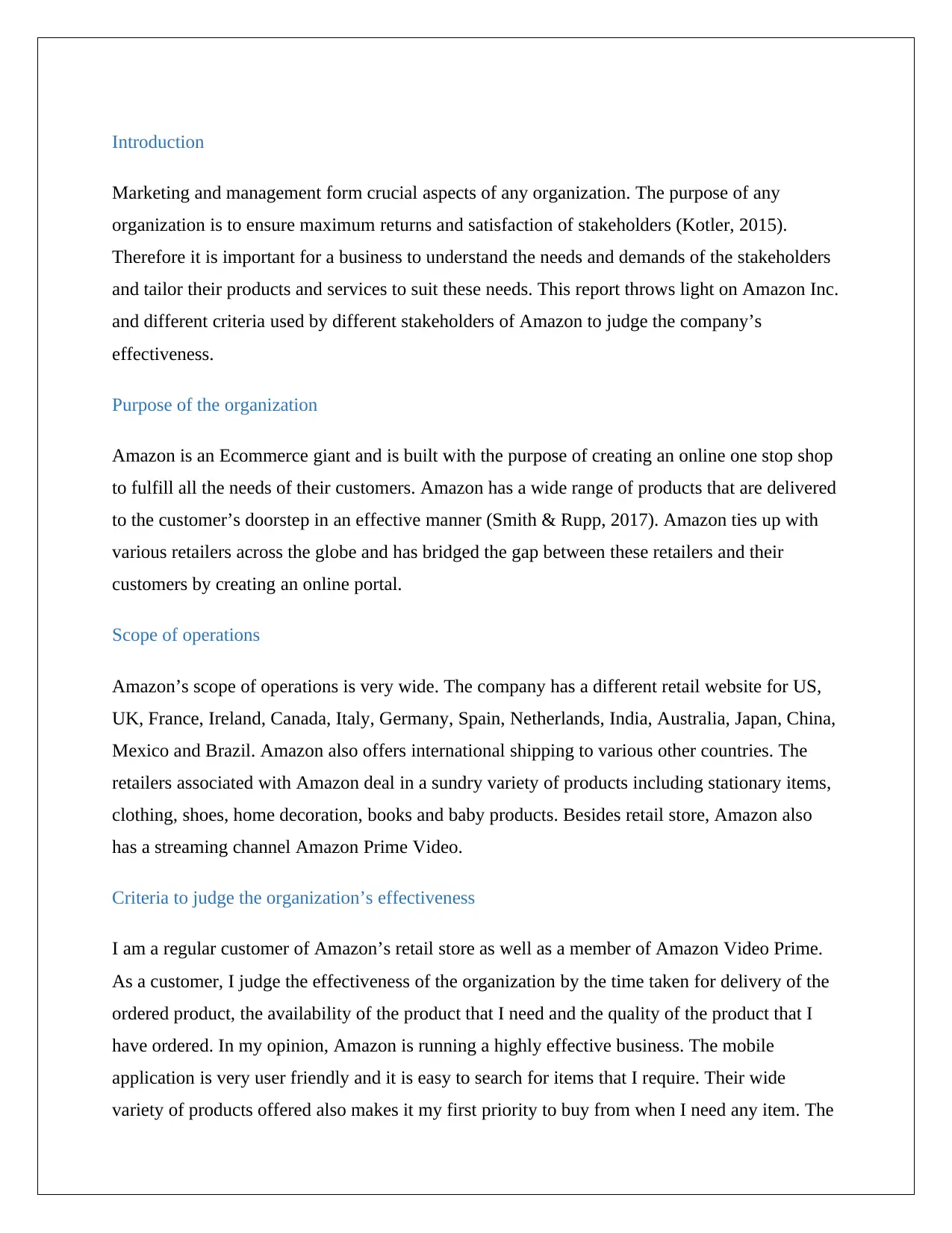
Introduction
Marketing and management form crucial aspects of any organization. The purpose of any
organization is to ensure maximum returns and satisfaction of stakeholders (Kotler, 2015).
Therefore it is important for a business to understand the needs and demands of the stakeholders
and tailor their products and services to suit these needs. This report throws light on Amazon Inc.
and different criteria used by different stakeholders of Amazon to judge the company’s
effectiveness.
Purpose of the organization
Amazon is an Ecommerce giant and is built with the purpose of creating an online one stop shop
to fulfill all the needs of their customers. Amazon has a wide range of products that are delivered
to the customer’s doorstep in an effective manner (Smith & Rupp, 2017). Amazon ties up with
various retailers across the globe and has bridged the gap between these retailers and their
customers by creating an online portal.
Scope of operations
Amazon’s scope of operations is very wide. The company has a different retail website for US,
UK, France, Ireland, Canada, Italy, Germany, Spain, Netherlands, India, Australia, Japan, China,
Mexico and Brazil. Amazon also offers international shipping to various other countries. The
retailers associated with Amazon deal in a sundry variety of products including stationary items,
clothing, shoes, home decoration, books and baby products. Besides retail store, Amazon also
has a streaming channel Amazon Prime Video.
Criteria to judge the organization’s effectiveness
I am a regular customer of Amazon’s retail store as well as a member of Amazon Video Prime.
As a customer, I judge the effectiveness of the organization by the time taken for delivery of the
ordered product, the availability of the product that I need and the quality of the product that I
have ordered. In my opinion, Amazon is running a highly effective business. The mobile
application is very user friendly and it is easy to search for items that I require. Their wide
variety of products offered also makes it my first priority to buy from when I need any item. The
Marketing and management form crucial aspects of any organization. The purpose of any
organization is to ensure maximum returns and satisfaction of stakeholders (Kotler, 2015).
Therefore it is important for a business to understand the needs and demands of the stakeholders
and tailor their products and services to suit these needs. This report throws light on Amazon Inc.
and different criteria used by different stakeholders of Amazon to judge the company’s
effectiveness.
Purpose of the organization
Amazon is an Ecommerce giant and is built with the purpose of creating an online one stop shop
to fulfill all the needs of their customers. Amazon has a wide range of products that are delivered
to the customer’s doorstep in an effective manner (Smith & Rupp, 2017). Amazon ties up with
various retailers across the globe and has bridged the gap between these retailers and their
customers by creating an online portal.
Scope of operations
Amazon’s scope of operations is very wide. The company has a different retail website for US,
UK, France, Ireland, Canada, Italy, Germany, Spain, Netherlands, India, Australia, Japan, China,
Mexico and Brazil. Amazon also offers international shipping to various other countries. The
retailers associated with Amazon deal in a sundry variety of products including stationary items,
clothing, shoes, home decoration, books and baby products. Besides retail store, Amazon also
has a streaming channel Amazon Prime Video.
Criteria to judge the organization’s effectiveness
I am a regular customer of Amazon’s retail store as well as a member of Amazon Video Prime.
As a customer, I judge the effectiveness of the organization by the time taken for delivery of the
ordered product, the availability of the product that I need and the quality of the product that I
have ordered. In my opinion, Amazon is running a highly effective business. The mobile
application is very user friendly and it is easy to search for items that I require. Their wide
variety of products offered also makes it my first priority to buy from when I need any item. The
⊘ This is a preview!⊘
Do you want full access?
Subscribe today to unlock all pages.

Trusted by 1+ million students worldwide
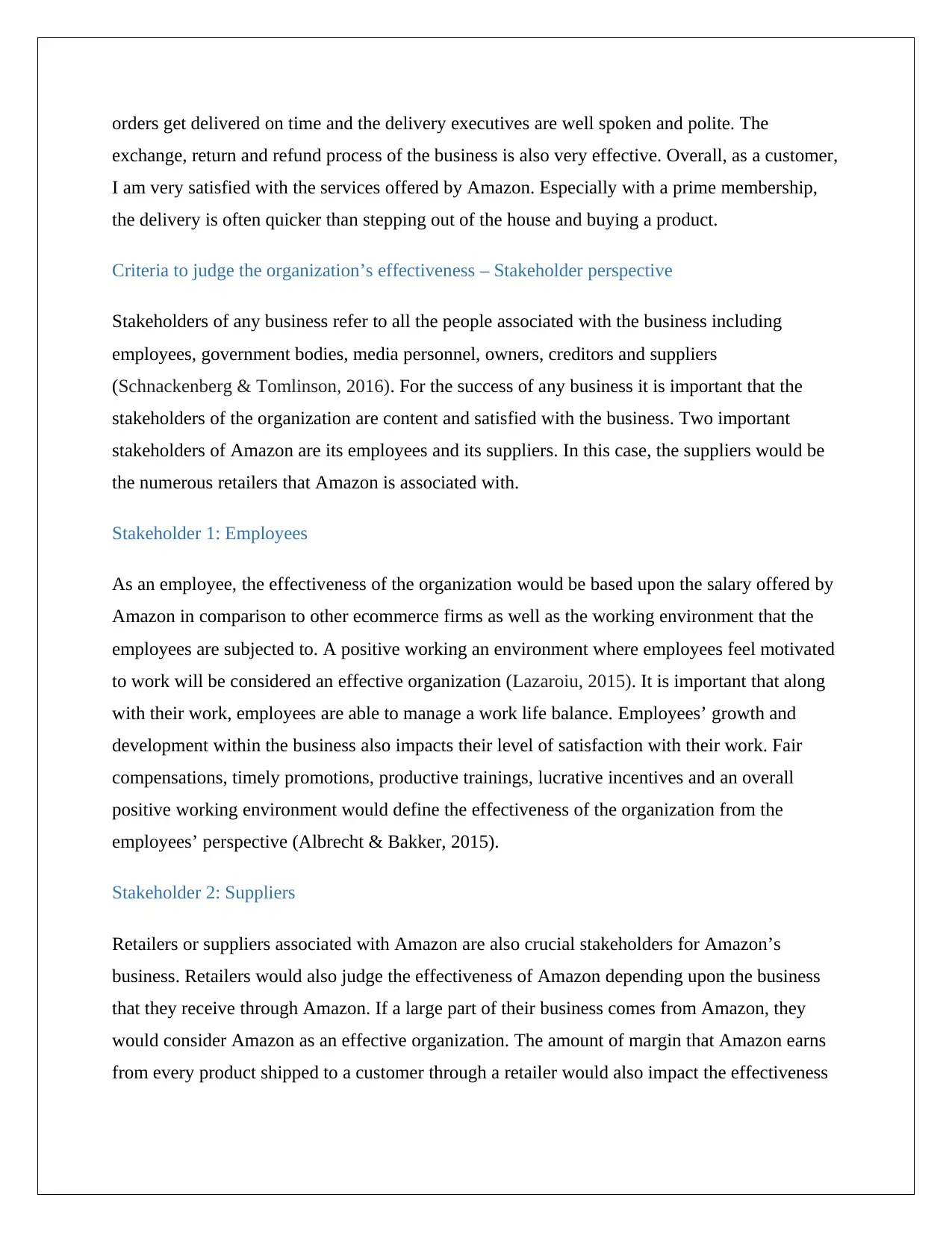
orders get delivered on time and the delivery executives are well spoken and polite. The
exchange, return and refund process of the business is also very effective. Overall, as a customer,
I am very satisfied with the services offered by Amazon. Especially with a prime membership,
the delivery is often quicker than stepping out of the house and buying a product.
Criteria to judge the organization’s effectiveness – Stakeholder perspective
Stakeholders of any business refer to all the people associated with the business including
employees, government bodies, media personnel, owners, creditors and suppliers
(Schnackenberg & Tomlinson, 2016). For the success of any business it is important that the
stakeholders of the organization are content and satisfied with the business. Two important
stakeholders of Amazon are its employees and its suppliers. In this case, the suppliers would be
the numerous retailers that Amazon is associated with.
Stakeholder 1: Employees
As an employee, the effectiveness of the organization would be based upon the salary offered by
Amazon in comparison to other ecommerce firms as well as the working environment that the
employees are subjected to. A positive working an environment where employees feel motivated
to work will be considered an effective organization (Lazaroiu, 2015). It is important that along
with their work, employees are able to manage a work life balance. Employees’ growth and
development within the business also impacts their level of satisfaction with their work. Fair
compensations, timely promotions, productive trainings, lucrative incentives and an overall
positive working environment would define the effectiveness of the organization from the
employees’ perspective (Albrecht & Bakker, 2015).
Stakeholder 2: Suppliers
Retailers or suppliers associated with Amazon are also crucial stakeholders for Amazon’s
business. Retailers would also judge the effectiveness of Amazon depending upon the business
that they receive through Amazon. If a large part of their business comes from Amazon, they
would consider Amazon as an effective organization. The amount of margin that Amazon earns
from every product shipped to a customer through a retailer would also impact the effectiveness
exchange, return and refund process of the business is also very effective. Overall, as a customer,
I am very satisfied with the services offered by Amazon. Especially with a prime membership,
the delivery is often quicker than stepping out of the house and buying a product.
Criteria to judge the organization’s effectiveness – Stakeholder perspective
Stakeholders of any business refer to all the people associated with the business including
employees, government bodies, media personnel, owners, creditors and suppliers
(Schnackenberg & Tomlinson, 2016). For the success of any business it is important that the
stakeholders of the organization are content and satisfied with the business. Two important
stakeholders of Amazon are its employees and its suppliers. In this case, the suppliers would be
the numerous retailers that Amazon is associated with.
Stakeholder 1: Employees
As an employee, the effectiveness of the organization would be based upon the salary offered by
Amazon in comparison to other ecommerce firms as well as the working environment that the
employees are subjected to. A positive working an environment where employees feel motivated
to work will be considered an effective organization (Lazaroiu, 2015). It is important that along
with their work, employees are able to manage a work life balance. Employees’ growth and
development within the business also impacts their level of satisfaction with their work. Fair
compensations, timely promotions, productive trainings, lucrative incentives and an overall
positive working environment would define the effectiveness of the organization from the
employees’ perspective (Albrecht & Bakker, 2015).
Stakeholder 2: Suppliers
Retailers or suppliers associated with Amazon are also crucial stakeholders for Amazon’s
business. Retailers would also judge the effectiveness of Amazon depending upon the business
that they receive through Amazon. If a large part of their business comes from Amazon, they
would consider Amazon as an effective organization. The amount of margin that Amazon earns
from every product shipped to a customer through a retailer would also impact the effectiveness
Paraphrase This Document
Need a fresh take? Get an instant paraphrase of this document with our AI Paraphraser
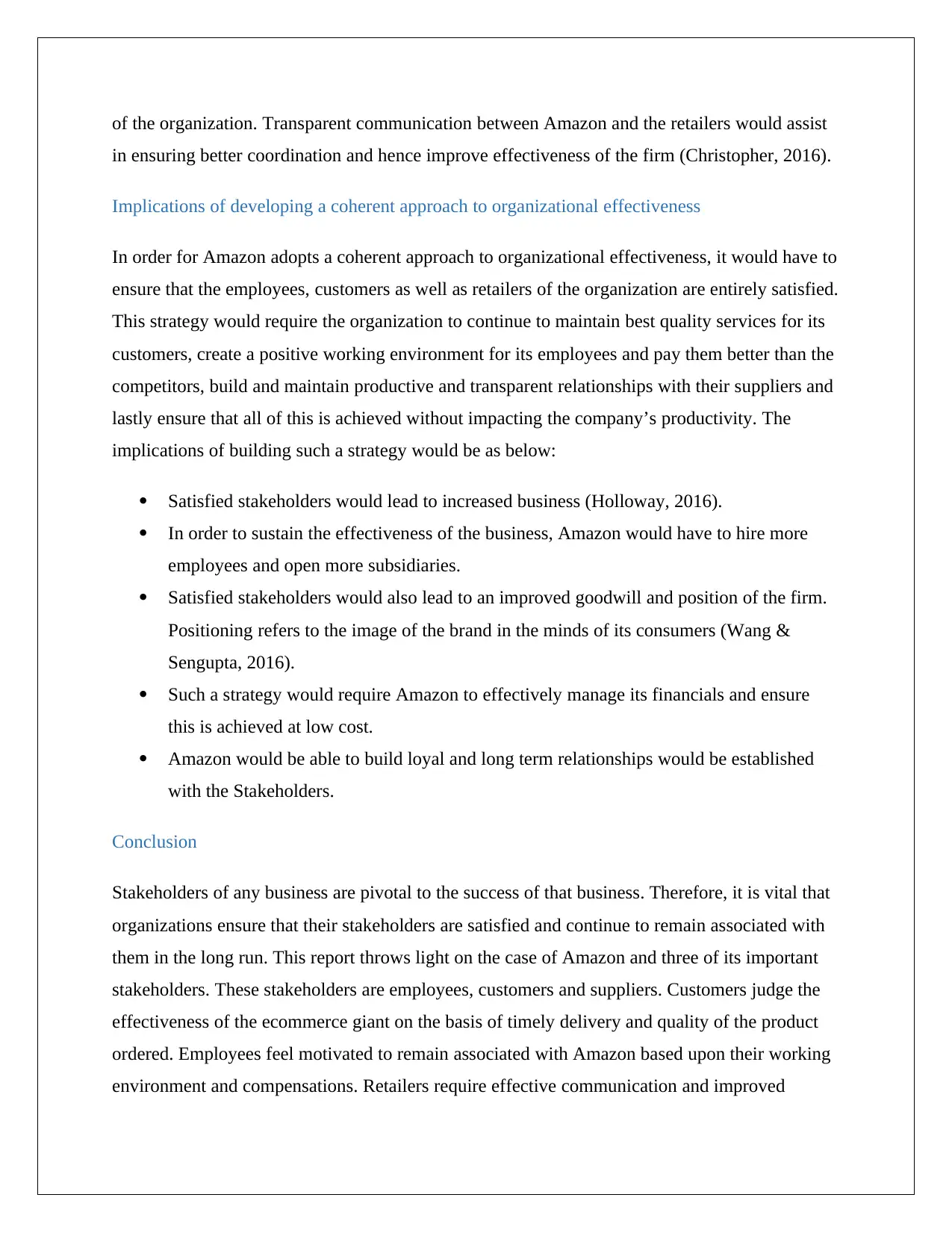
of the organization. Transparent communication between Amazon and the retailers would assist
in ensuring better coordination and hence improve effectiveness of the firm (Christopher, 2016).
Implications of developing a coherent approach to organizational effectiveness
In order for Amazon adopts a coherent approach to organizational effectiveness, it would have to
ensure that the employees, customers as well as retailers of the organization are entirely satisfied.
This strategy would require the organization to continue to maintain best quality services for its
customers, create a positive working environment for its employees and pay them better than the
competitors, build and maintain productive and transparent relationships with their suppliers and
lastly ensure that all of this is achieved without impacting the company’s productivity. The
implications of building such a strategy would be as below:
Satisfied stakeholders would lead to increased business (Holloway, 2016).
In order to sustain the effectiveness of the business, Amazon would have to hire more
employees and open more subsidiaries.
Satisfied stakeholders would also lead to an improved goodwill and position of the firm.
Positioning refers to the image of the brand in the minds of its consumers (Wang &
Sengupta, 2016).
Such a strategy would require Amazon to effectively manage its financials and ensure
this is achieved at low cost.
Amazon would be able to build loyal and long term relationships would be established
with the Stakeholders.
Conclusion
Stakeholders of any business are pivotal to the success of that business. Therefore, it is vital that
organizations ensure that their stakeholders are satisfied and continue to remain associated with
them in the long run. This report throws light on the case of Amazon and three of its important
stakeholders. These stakeholders are employees, customers and suppliers. Customers judge the
effectiveness of the ecommerce giant on the basis of timely delivery and quality of the product
ordered. Employees feel motivated to remain associated with Amazon based upon their working
environment and compensations. Retailers require effective communication and improved
in ensuring better coordination and hence improve effectiveness of the firm (Christopher, 2016).
Implications of developing a coherent approach to organizational effectiveness
In order for Amazon adopts a coherent approach to organizational effectiveness, it would have to
ensure that the employees, customers as well as retailers of the organization are entirely satisfied.
This strategy would require the organization to continue to maintain best quality services for its
customers, create a positive working environment for its employees and pay them better than the
competitors, build and maintain productive and transparent relationships with their suppliers and
lastly ensure that all of this is achieved without impacting the company’s productivity. The
implications of building such a strategy would be as below:
Satisfied stakeholders would lead to increased business (Holloway, 2016).
In order to sustain the effectiveness of the business, Amazon would have to hire more
employees and open more subsidiaries.
Satisfied stakeholders would also lead to an improved goodwill and position of the firm.
Positioning refers to the image of the brand in the minds of its consumers (Wang &
Sengupta, 2016).
Such a strategy would require Amazon to effectively manage its financials and ensure
this is achieved at low cost.
Amazon would be able to build loyal and long term relationships would be established
with the Stakeholders.
Conclusion
Stakeholders of any business are pivotal to the success of that business. Therefore, it is vital that
organizations ensure that their stakeholders are satisfied and continue to remain associated with
them in the long run. This report throws light on the case of Amazon and three of its important
stakeholders. These stakeholders are employees, customers and suppliers. Customers judge the
effectiveness of the ecommerce giant on the basis of timely delivery and quality of the product
ordered. Employees feel motivated to remain associated with Amazon based upon their working
environment and compensations. Retailers require effective communication and improved

business from the firm in order to build a long term relationship. Therefore Amazon could work
upon a coherent strategy that would help in fulfilling the needs of these stakeholders.
upon a coherent strategy that would help in fulfilling the needs of these stakeholders.
⊘ This is a preview!⊘
Do you want full access?
Subscribe today to unlock all pages.

Trusted by 1+ million students worldwide
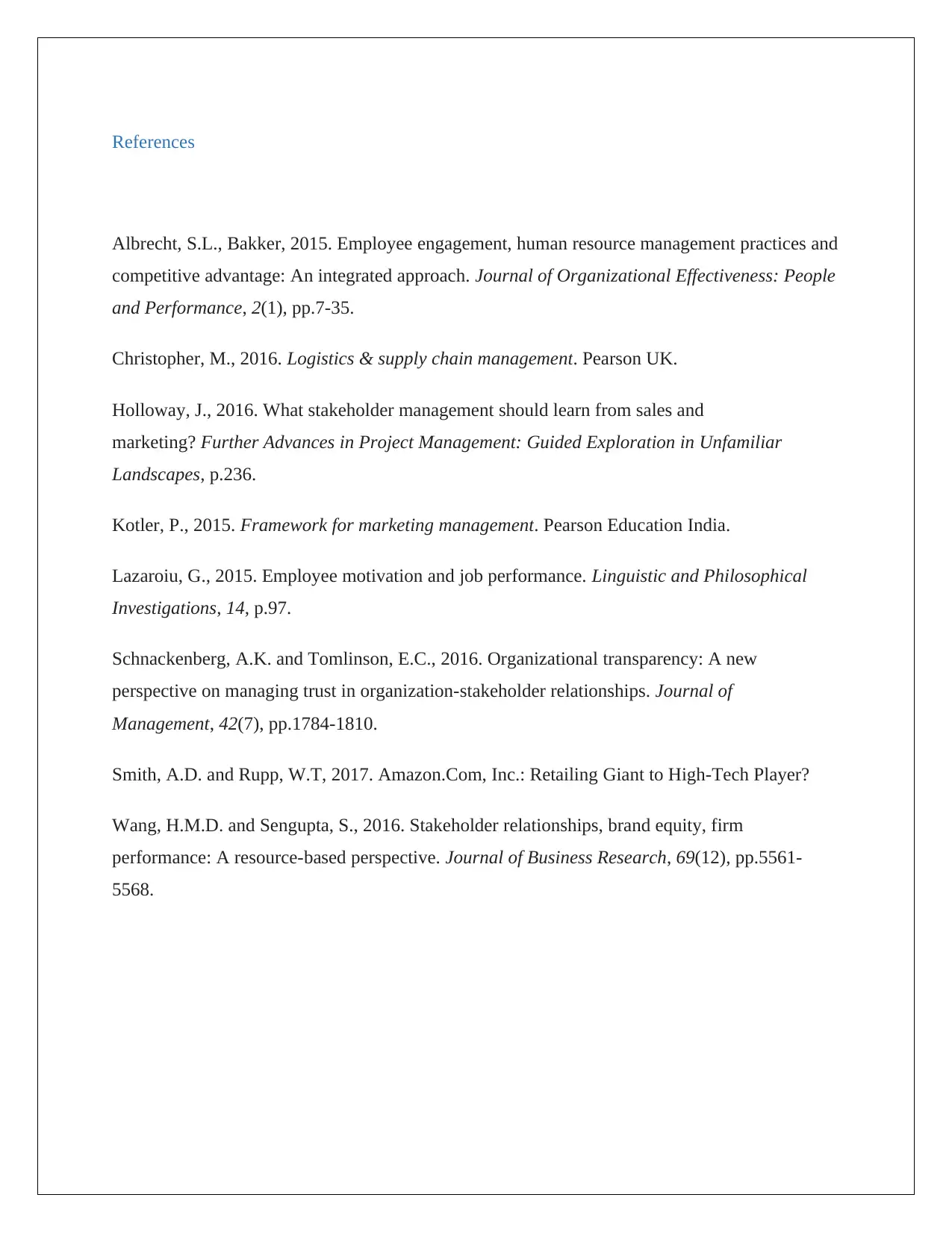
References
Albrecht, S.L., Bakker, 2015. Employee engagement, human resource management practices and
competitive advantage: An integrated approach. Journal of Organizational Effectiveness: People
and Performance, 2(1), pp.7-35.
Christopher, M., 2016. Logistics & supply chain management. Pearson UK.
Holloway, J., 2016. What stakeholder management should learn from sales and
marketing? Further Advances in Project Management: Guided Exploration in Unfamiliar
Landscapes, p.236.
Kotler, P., 2015. Framework for marketing management. Pearson Education India.
Lazaroiu, G., 2015. Employee motivation and job performance. Linguistic and Philosophical
Investigations, 14, p.97.
Schnackenberg, A.K. and Tomlinson, E.C., 2016. Organizational transparency: A new
perspective on managing trust in organization-stakeholder relationships. Journal of
Management, 42(7), pp.1784-1810.
Smith, A.D. and Rupp, W.T, 2017. Amazon.Com, Inc.: Retailing Giant to High-Tech Player?
Wang, H.M.D. and Sengupta, S., 2016. Stakeholder relationships, brand equity, firm
performance: A resource-based perspective. Journal of Business Research, 69(12), pp.5561-
5568.
Albrecht, S.L., Bakker, 2015. Employee engagement, human resource management practices and
competitive advantage: An integrated approach. Journal of Organizational Effectiveness: People
and Performance, 2(1), pp.7-35.
Christopher, M., 2016. Logistics & supply chain management. Pearson UK.
Holloway, J., 2016. What stakeholder management should learn from sales and
marketing? Further Advances in Project Management: Guided Exploration in Unfamiliar
Landscapes, p.236.
Kotler, P., 2015. Framework for marketing management. Pearson Education India.
Lazaroiu, G., 2015. Employee motivation and job performance. Linguistic and Philosophical
Investigations, 14, p.97.
Schnackenberg, A.K. and Tomlinson, E.C., 2016. Organizational transparency: A new
perspective on managing trust in organization-stakeholder relationships. Journal of
Management, 42(7), pp.1784-1810.
Smith, A.D. and Rupp, W.T, 2017. Amazon.Com, Inc.: Retailing Giant to High-Tech Player?
Wang, H.M.D. and Sengupta, S., 2016. Stakeholder relationships, brand equity, firm
performance: A resource-based perspective. Journal of Business Research, 69(12), pp.5561-
5568.
1 out of 7
Related Documents
Your All-in-One AI-Powered Toolkit for Academic Success.
+13062052269
info@desklib.com
Available 24*7 on WhatsApp / Email
![[object Object]](/_next/static/media/star-bottom.7253800d.svg)
Unlock your academic potential
Copyright © 2020–2025 A2Z Services. All Rights Reserved. Developed and managed by ZUCOL.




